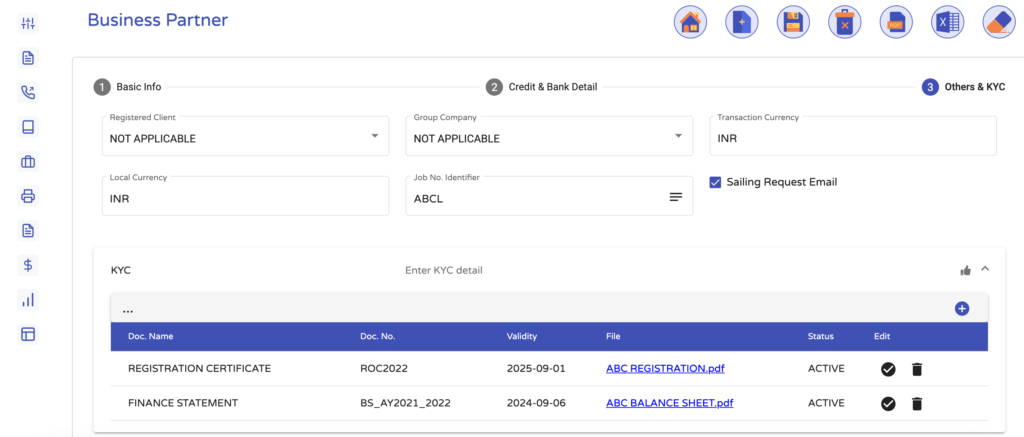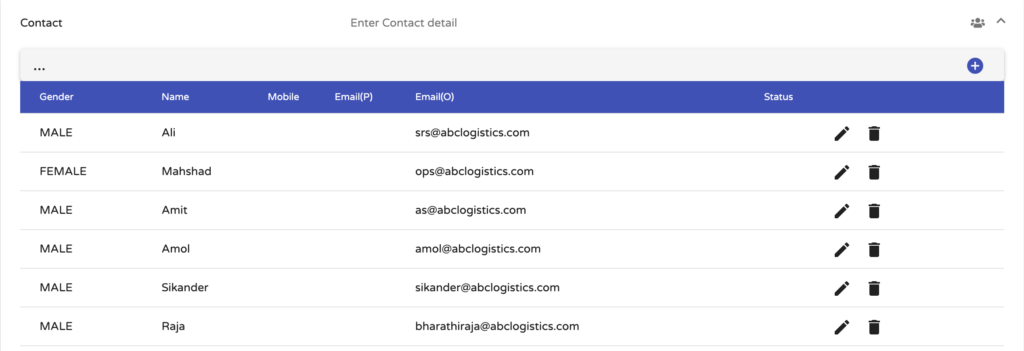Customer and supplier profile management is a crucial aspect of business operations, especially for companies that rely on maintaining strong relationships with their customers and suppliers. Effective profile management helps businesses streamline their interactions, provide better services, and make informed decisions. Here’s an overview of how to manage customer and supplier profiles:
Data Collection: Gather relevant information about your customers. This typically includes their name, contact details, company information (if applicable), purchase history, credit limit, credit days, KYC documents, preferences, and any other data that helps you understand their needs and behaviors.

Source: BlueLogis FX/AX/NX – Creation of Customer & Supplier
Centralized Database: Maintain a centralized database (CRM) system to store and organize customer information. This allows for easy access and retrieval of data when needed.
Segmentation, Communication & Evaluate Performance: Segment your customer base based on factors like sea, air, road shipments, demographics, buying behavior, and preferences. This segmentation helps in tailoring automated shipment status alerts and customer service efforts. Use the customer profiles to personalize communication. Send targeted auto-emails, service recommendations, and special offers based on their preferences and purchase history. Regularly evaluate your suppliers’ performance to ensure they meet quality, cost, and delivery expectations. Keep records of these evaluations in their profiles.

Source: BlueLogis FX/AX/NX – Rating, Auto-Email Setup of Customer & Supplier
KYC Management: Maintain copies of KYC documents, contracts, agreements, and terms of service with customers and suppliers in their profiles. This ensures easy reference when issues arise or renegotiations are needed.
- Business Documents (for businesses and organizations):
- Certificate of incorporation
- Partnership agreement
- Business license
- Tax identification number (TIN)
- Financial Statements (for businesses and organizations):
- Balance sheets
- Profit and loss statements
- Audited financial reports

Source: BlueLogis FX/AX/NX – KYC of Customer & Supplier
Data Security: Protect customer data and comply with relevant data privacy regulations, such as GDPR or CCPA, to maintain trust.
Supplier Communication: Establish clear communication channels with suppliers. Ensure they have a dedicated contact person within your organization, and maintain records of all communications. Vendor RFQs can be automated through clearly established communication channels.

Source: BlueLogis FX/AX/NX – Customer & Supplier Contacts Management
Inventory and Ordering: Monitor inventory levels and place orders with suppliers as needed. A well-managed supplier profile can help streamline this process.
Risk Management: Identify and manage risks associated with suppliers. This includes evaluating financial stability, geographical location, and potential supply chain disruptions.
Debtors (Accounts Receivable) & Creditors (Accounts Payable) Entries:
Maintain a record of all financial transactions with customers and suppliers, including invoices, bills, receipts, payments, and any disputes that may arise. A debtors and creditors chart of entries, also known as an accounts receivable and accounts payable ledger, is a record-keeping system used by businesses to track transactions related to money owed to them by customers (debtors) and money they owe to suppliers or vendors (creditors). Here are some typical entries you might find in such a ledger:

Source: BlueLogis FX/AX/NX – Debtors & Creditors Chart of Entries Setup
Sales Invoice Entry: When you make a sale to a customer on credit, you record the transaction with a sales invoice. The entry would look like this:
| Date | Description | Debit (Accounts Receivable) | Credit (Sales Revenue) |
|---|---|---|---|
| 07-SEP-2023 | Sales to ABC LOGISTICS | USD 5000 | USD 5000 |
Sales Adjustment Entry: If there are any adjustments, like discounts or sales returns, you make corresponding entries:
| Date | Description | Debit (Discounts) | Credit (Accounts Receivable) |
|---|---|---|---|
| 08-SEP-2023 | Discount for ABC LOGISTICS | USD 450 | USD 450 |
Receipt Entry: When the customer pays their invoice, you record the payment:
| Date | Description | Debit (Cash/Bank) | Credit (Accounts Receivable) |
|---|---|---|---|
| 09-SEP-2023 | Receipt from ABC LOGISTICS | USD 5550 | USD 5550 |
Purchase Invoice Entry: When you purchase goods or services on credit from a supplier, you record the transaction with a purchase invoice:
| Date | Description | Debit (Expense) | Credit (Accounts Payable) |
|---|---|---|---|
| 05-SEP-2023 | Purchase from HMM SHIPPING LINE | USD 2500 | USD 2500 |
Purchase Adjustment Entry: If there are any adjustments, like purchase returns or discounts, you make corresponding entries:
| Date | Description | Debit (Accounts Payable) | Credit(Discounts) |
|---|---|---|---|
| 06-SEP-2023 | Discount from HMM SHIPPING LINE | USD 250 | USD 250 |
Payment Entry: When you pay the supplier invoice, you record the payment:
| Date | Description | Debit (Accounts Payable) | Credit (Cash/Bank) |
|---|---|---|---|
| 10-SEP-2023 | Payment to HMM SHIPPING LINE | USD 2250 | USD 2250 |
The ledger helps businesses keep track of outstanding receivables and payables, ensuring they are paid on time and managing cash flow effectively. It’s essential for maintaining financial stability and accuracy in your records. Please note that the specific account titles and entries may vary depending on your accounting system and the business type you are in whether forwarding or agency or principal. It’s also advisable to consult with an accountant to ensure accurate and compliant record-keeping.
Both customer and supplier profile management systems can benefit from the use of software tools and technology solutions. These tools can help automate processes, improve data accuracy, and enhance overall efficiency in managing these important business relationships.
Now is the time to automate debtor and creditor management !!
DIY VIDEOS